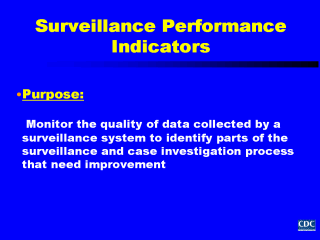Search for most updated materials ↑
 |
 |
front |1 |2 |3 |4 |5 |6 |7
|8 |9 |10 |11 |12 |13 |14 |15 |16 |17 |18 |19 |20 |21 |22 |23 |24 |25 |26 |27 |28 |review |
 Did you see the Part I of this lecture? Analysis of surveillance data is important not only for telling us about the occurrence of diseases, exposures, and health behaviors, but also about how well our surveillance system itself is performing. To monitor the quality of data collected by our surveillance system, we look at surveillance performance indicators. These indicators help us identify parts of our surveillance system and case investigation process that need improvement,and help us determine ways in which our case ascertainment can be more complete, that is, ensure that our surveillance system is detecting all the cases of disease, health conditions, or exposures that truly exist in our population of interest. A high degree of case ascertainment will assure us that once we see an absence of reported disease or exposure within a community it represents a true absence in the population rather than a failure to detect cases or exposures that still exist. |
 |
 |
front |1 |2 |3 |4 |5 |6 |7
|8 |9 |10 |11 |12 |13 |14 |15 |16 |17 |18 |19 |20 |21 |22 |23 |24 |25 |26 |27 |28 |review |